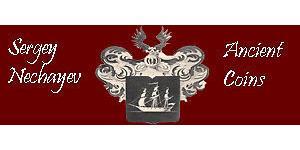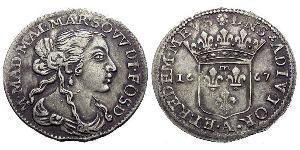1 Statere
[ 5900] GREEK ISLANDS OFF ATTICA, AEGINA - Silver Stater (12.37 gm.) Struck 458-431 B.C. Excellent centering. Very high relief. Reference: Delepierre 1774 ; BMC pl. 24.11. Sea turtle. Incuse pattern. The island-state of Aigina, situated midway between Attica and the coastline of Argolis, was probably the first pace in European Greece to issue coinage. From Aigina the practice quickly spread to Athens and Corinth, Euboia, and other important centers. The Aiginetic weight standard, based on a didrachm-stater of about 12.6 grams, was widely adopted in Crete and Asia Minor as well as Greece. Although sill a place of some importance in the 5th and 4th centuries, Aigina was eclipsed by Athens after the Persian Wars, and never regained her former position as one of the greatest trading states of the Greek World. The city was captured by the Athenians in 456 B.C., and a quarter of a century later the inhabitants were expelled from the island. In 404 B.C., after the fall of Athens, the exiles were restored to their homes. Provided with certificate of authenticity. CERTIFIED AUTHENTIC by Sergey Nechayev, PhD - Numismatic Expert Aegina (Greek: Αίγινα (Egina)) is one of the Saronic Islands of Greece in the Saronic Gulf, 17 miles (27 km) from Athens. Tradition derives the name from Aegina, the mother of Aeacus, who was born in and ruled the island. During ancient times, Aegina was a rival to Athens, the great sea power of the era. The island, along with offshore islets, comprises the Municipality of Aegina in Piraeus Prefecture, a part of the Attica region. The capital is the town of Aegina (pop. 7,410 in 2001 census), situated at the northwestern end of the island. Due to its proximity to Athens, it is a popular quick getaway during the summer months, with quite a few Athenians owning second houses on the island. Besides the town of Aegina, the largest other towns and villages on the island are Kypséli (pop. 1,949), Vathý (1,474), Mesagrós (682), Pérdika (682), Agía Marína (426), Vaïa (239), Álones (233), and Kontós (178). Geography Aegina is roughly triangular in shape, approximately 15 km (9.3 mi) from east to west and 10 km (6.2 mi) from north to south, with an area of about 87 km2 (34 sq mi). An extinct volcano constitutes two thirds of Aegina. The northern and western side consist of stony but fertile plains, which are well cultivated and produce luxuriant crops of grain, with some cotton, vines, almonds, olives and figs, but the most characteristic crop of Aegina today (2000s) is pistachio. Economically, the sponge fisheries are of notable importance. The southern volcanic part of the island is rugged and mountainous, and largely barren. Its highest rise is the conical Mount Oros (531 m) in the south, and the Panhellenian ridge stretches northward with narrow fertile valleys on either side. The beaches are also a popular tourist attraction. Hydrofoil ferries from Piraeus take only forty minutes to reach Aegina; the regular ferry takes about an hour, with ticket prices for adults within the 4-15 euro range. There are regular bus services from Aegina town to destinations throughout the island such as Agia Marina. History Prehistory Prehistoric archaeological findings of settlements with obsidian tools points to an early habitation of the island. [citation needed] Earliest history (20th–7th centuries BC) Aegina, according to Herodotus, was a colony of Epidaurus, to which state it was originally subject. Its placement between Attica and the Peloponnesus made it a center of trade even earlier, and its earliest inhabitant came from Asia Minor. Minoan ceramics have been found in contexts of ca. 2000 BC. The discovery in the island of a number of gold ornaments belonging to the latest period of Mycenaean art suggests the inference that the Mycenaean culture held its own in Aegina for some generations after the Dorian conquest of Argos and Lacedaemon. It is pro ...
altro

|
Postato da:
anonymous 2015-08-18 |
|
||
|
||
|
||
Queste monete potrebbero interessarti
2024-04-16
- New coin is added to 1 Farthing Regno d'Inghilterra (927-1649,1660-1707) Bronzo C ...
1 Farthing Regno d'Inghilterra (927-1649,1660-1707) Bronzo C ...
il gruppo ha 2 monete / 1 prezzi
⇑
1649, Great Britain, Charles I. Scarce "Rose" Farthing Coin. VF+
Condition: VF+ Denomination: Farthing Mint Period: 1635/6-1644 Mint Place: Tower mint (London) Referenc ...
2024-04-16
- New coin is added to 1 Luigino Italian city-states Argento
1 Luigino Italian city-states Argento
il gruppo ha 21 monete / 20 prezzi
⇑
1666, Italian States, Tassarolo. Scarce Silver Luigino (1/12 Ecu) Coin. R!
Mint Year: 1666 State: Tassarolo (Italian State) Condition: Lightly corroded, otherwise VF+ References: C ...
Potresti essere interessato in…

-600-300-apQKbzbibs0AAAFP6Mir70ML.jpg)

-300-150-GYMKbzbi81AAAAFPz9qr70ML.jpg)
 English
English




-300-150-J7MKbzbig6gAAAFOhSznFjDh.jpg)








